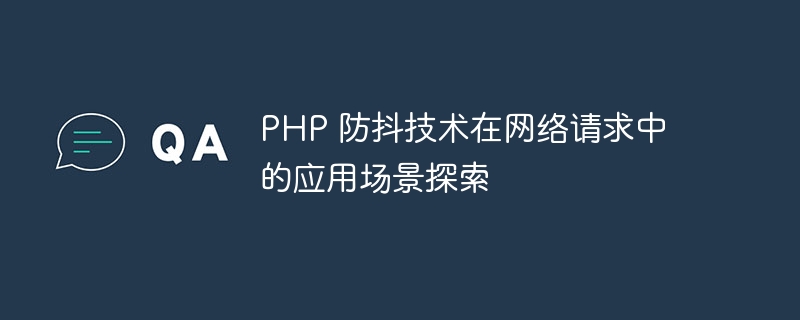Home >Backend Development >PHP Tutorial >Exploration of application scenarios of PHP anti-shake technology in network requests
Exploration of application scenarios of PHP anti-shake technology in network requests
- 王林Original
- 2023-10-12 11:02:08881browse

Exploration of application scenarios of PHP anti-shake technology in network requests
Introduction: With the rapid development of the Internet, the frequent use of network requests has become our daily development normality. However, frequent network requests also bring some problems, such as excessive server pressure and long request processing time. In order to solve these problems, anti-shake technology came into being. This article will explore the application scenarios of PHP anti-shake technology in network requests and provide relevant code examples.
1. Overview of anti-shake technology
Anti-shake technology is a strategy that reduces the number of frequent triggers of events by delaying trigger events. In network requests, anti-shake technology can be used to limit the frequency of users continuously clicking buttons, ensuring sufficient processing time for each request, and reducing server processing pressure.
2. Specific implementation of PHP anti-shake technology
- Option 1: Use JavaScript to implement simple anti-shake
Achieved through JavaScript in the front-end page Simple anti-shake can reduce the trigger frequency of network requests. For example, we can add a delay timer to achieve an anti-shake effect after clicking a button.
// HTML代码
<button id="btn">点击按钮</button>
<script>
let timer = null;
document.getElementById('btn').addEventListener('click', function() {
// 点击按钮后清除前一个定时器
clearTimeout(timer);
timer = setTimeout(function() {
// 执行网络请求的代码
// ...
}, 200);
});
</script>- Option 2: Combine PHP and AJAX to achieve more complete anti-shake
In actual projects, we may need to use PHP on the back end to handle network requests. Combining PHP and AJAX can achieve more complete anti-shake technology. The following is a sample code that shows how to use anti-shake technology in PHP:
<!-- HTML代码 -->
<button id="btn">点击按钮</button>
<script src="https://code.jquery.com/jquery-3.5.1.min.js"></script>
<script>
let timer = null;
$('#btn').click(function() {
// 清除前一个定时器
clearTimeout(timer);
timer = setTimeout(function() {
$.ajax({
url: 'process.php',
type: 'POST',
success: function(response) {
// 请求成功后的处理逻辑
// ...
}
});
}, 200);
});
</script>// PHP代码(process.php) <?php // 处理网络请求的逻辑 // ... ?>
- Option 3: Server-side control request frequency
In addition to using anti-shake on the front end Technology, we can also control the request frequency at the backend server level. By setting a reasonable request processing cycle, the pressure on the server can be reduced.
The following is a simple PHP code example that shows how to control the request frequency on the backend:
<?php
$lastRequestTime = // 从数据库或缓存中获取上一次请求时间
$currentRequestTime = time();
$waitTime = 500; // 限定每500毫秒处理一次请求
if ($currentRequestTime - $lastRequestTime < $waitTime) {
// 请求间隔时间过短,拒绝处理请求
echo '请求过于频繁,请稍后再试!';
exit;
}
// 处理网络请求的逻辑
// ...
// 更新请求时间
// updateLastRequestTime($currentRequestTime);
?>3. Conclusion
This article introduces the application of PHP anti-shake technology in the network Application scenarios in the request and specific code examples are given. By using anti-shake technology, the pressure on the server can be effectively reduced and the user experience improved. In actual development, you can choose an appropriate anti-shake solution according to different needs, or use it together on the front and back ends to obtain better results. I hope this article can provide some reference for PHP developers on the application of anti-shake technology in network requests.
The above is the detailed content of Exploration of application scenarios of PHP anti-shake technology in network requests. For more information, please follow other related articles on the PHP Chinese website!

